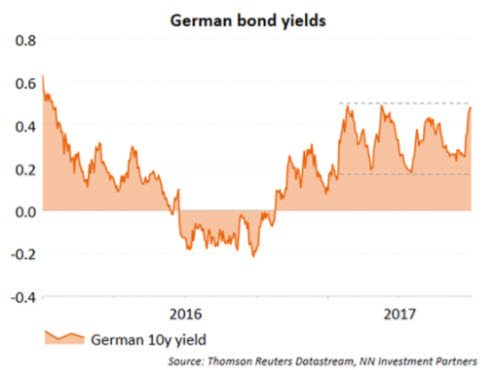
NN IP: Making Markets Move
Central bank policies, inflation expectations and investor positioning may weigh on government bonds and create some bouts of volatility in equity markets in the short term, but they will not structurally undermine the rally in risky assets.
11.07.2017 | 12:49 Uhr

(Foto: Valentijn van Nieuwenhuijzen, Head of Multi Asset; Patrick Moonen, Principal Strategist Multi Asset)
Was it that Draghi sounded more optimistic or the detection of a hidden pact among central bankers that made bond markets move so dramatically over the week? Maybe just the awareness that global growth continues to hum along just fine and that Janet Yellen has been right to point out that most of the recent fall-back in inflation numbers was probably temporary in nature. With oil prices rising again and economic data surprises showing tentative signs of bottoming, it can also be explained "fundamentally" that upward pressure on bond yields needed to come back.
Or had investor positioning simply become so concentrated in the longer part of yield curves? Had bund and treasury futures exposures just become so crowded that underlying bond market fragility was created in recent weeks, and that a butterfly-effect from any miniscule trigger was bound to create damage at some point during the summer? And was that point simply reached last week?
Or even more mystifying, was it a reflection of the inherent complexity of the global market system, which is an organism of its own? An ecology in which all different components are mutually influential, and patterns of behaviour at the surface are regularly unexplainable. Even if all agents in such a markets are rational or use straightforward heuristics (decision-making rules) such unexpected patterns can easily emerge. And when it does, it’s very hard to resist the temptation to “find” a narrative that explains the mystery with the benefit of hindsight. Even if such a story sounds right, it might not be right!
So, let’s diversify our bets and conclude that it was most likely a bit of all these factors at play that caused bond yields to jump last week. Central bankers making some noise, data and oil reflating inflation hopes a bit, and investor positioning being tilted too much towards long-maturity bonds. Certainly our own tools had been hinting in the direction of some behavioural fragility as CFTC positioning in US treasuries, weakening ETF flows and our Big Data mapping of social and professional news flow all pointed to near-term risks for government bonds.
At least we know that markets have moved. And we have some idea of what might be behind it. What does this tell us about the future? That it remains an uncertain place, to start with. No matter what happened in the past, there is always the possibility that new factors may come into play. Some of them we might be able to imagine (corporate earnings news, politics, etc.), but some will always be hiding in the dark only to emerge as a black swan at an unpredictable moment.

Houseview 20 2017 Equity Strategy
Often there is also a certain persistence in the driving factors of markets, however. If that is the case, the healthy macro news in combination with rebounding oil prices points to global central banks’ ongoing commitment to further normalise their policy setting. They are doing so gradually, but they are still focused on unwinding QE policies and preparing markets for rate hikes to come. If this normalisation process is carried out for the good reasons (stronger growth, rising inflation expectations), it will weigh on government bonds and create some bouts of volatility in equity markets, but it will not structurally undermine the rally in risky assets.
In the shorter term, however, the trade-off might look a bit different. Technical factors might limit the degree to which bond yields can rise further. The recent increase was very fast, especially for German bunds yields, which have moved all the way to the upper end of their remarkably stable trading range since the begin of this year (see graph). As long as this range is not broken to the upside (10-year yields firmly above 50 bps), we might well see a more sideways or modest down-ward drift in yields in the short term. Similarly, equity markets might remain a bit directionless until further tangible support from the upcoming earnings season starts to arrive next week.
As always, we monitor these shorter term factors and integrate them into our market timing and risk management decisions. They do not, however, dominate our overall risk stance in the asset allocation. Fundamental, policy and behaviour factors like positioning and herding trends still provide more than enough support for risky assets like equities and fixed income spread products to be tilted in that direction. Markets need to move and we move where we need to move – not on the overall risk-tilt this time around.



Diesen Beitrag teilen: